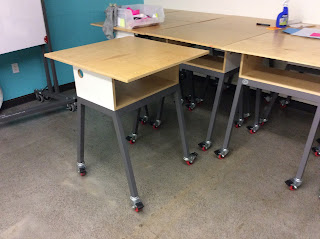Later Thursday afternoon, I broke from high schools and visited Stanford's Design School, known as the d.school. I joined another Oliner, Andrea, who was the TA for an undergraduate 101 course that served as an introduction to design (a course that recently was approved to meet Stanford's creative expression requirement). The last day of class turned out to be a great time to jump in -- I saw final presentations, students' finished design notebooks, the professor's summarizing lecture that pulled everything together and reviewed what they learned over the quarter, and I ate some of their coffee and donuts.
The student presentations followed a simple format: introduce a persona character, state their problem, walk the audience through your idea generation / sketches, present your solution (slides and a physical prototype), and explain how the solution solves the character's problem. Most students did a great job keeping slides clean and highly visual. Many also used humor throughout their presentation to engage the audience. The prototypes were not particularly high quality, but that was not the intent -- they needed to work through multiple iterations of the design to make sure that they were really solving the user's problem. For this particular project, students worked alone and they were their own user, so this step was much simpler.
The summary at the end focused on the key attributes of the course. His goal was to increase students' fluidity and flexibility with idea generation using open-ended sketches and structured activities. He gave a few assignments specifically to improve students' ability to make realistic sketches. He talked through five key habits of designers: use radical collaboration (teams of people from very different backgrounds), reframe problems in new ways, use curiosity and wonder, be mindful of the design process, and always have a bias toward action (when in doubt, start making something). He also pointed students to resources they could (and I could) continue to use: the collaboration toolkit and the rules of brainstorming. Finally, he ended with a "pinning ceremony", where all students had to find someone near them and award them with a small black pin to signify that they are now designers. It was a neat way to end a course. Even I got pinned!
After class, Andrea took me on a tour through the spaces. For being so well known worldwide, it is actually pretty small -- about a building and a half of space. Everything, literally everything, was on wheels (nice ones too). They deeply believe in the importance of physical space and its layout, and thus the ability to quickly reconfigure the room as needs change. They don't have white walls, opting for color all over. Whiteboards are everywhere -- some hang on a hook so you can leave your sketches up over time (just move your board to the back of the hook), while others are large and roll on coat rack bases. There are small, quiet team spaces and large open areas (with the ability to sub-divide them into more intimate ones). Graduate students had a little cubby area where they could store projects in progress with open lab tables in the middle of the room to use while actively working.
I plan to borrow lots of these ideas as we build out our robotics lab / Grand Challenge Design classroom this summer. Most of the concepts are low-cost, but yield a number of great ways to setup a working and learning environment. I also have to embrace the idea that design is messy, all while figuring out strategies to keep our space clean enough to use for multiple purposes throughout the day.







No comments:
Post a Comment